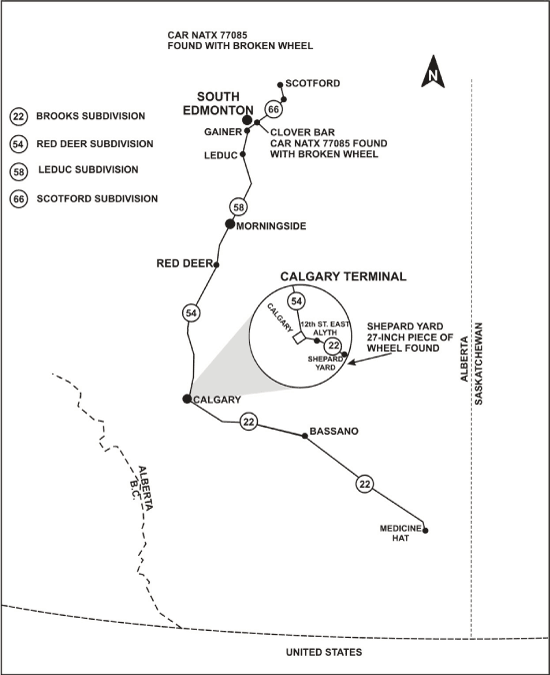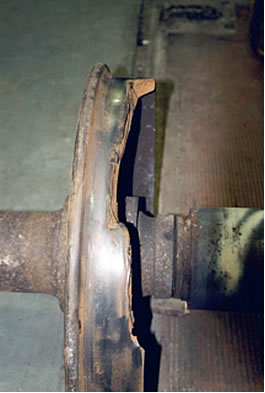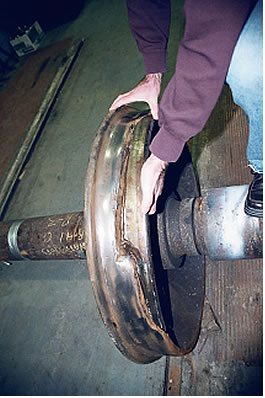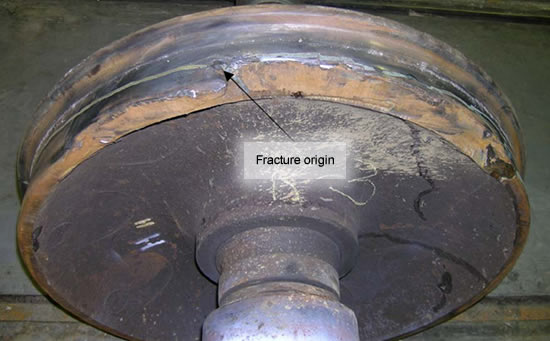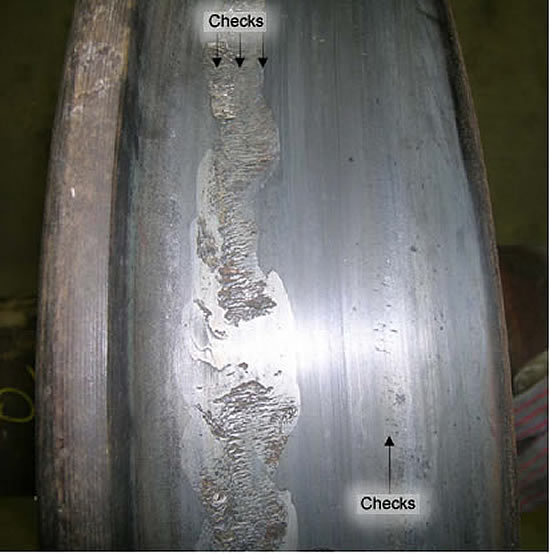Rolling stock damage
Canadian Pacific Railway
Car NATX 77085
Mile 165.6, Scotford Subdivision
Clover Bar
Edmonton, Alberta
The Transportation Safety Board of Canada (TSB) investigated this occurrence for the purpose of advancing transportation safety. It is not the function of the Board to assign fault or determine civil or criminal liability. This report is not created for use in the context of legal, disciplinary or other proceedings. See Ownership and use of content. Masculine pronouns and position titles may be used to signify all genders to comply with the Canadian Transportation Accident Investigation and Safety Board Act (S.C. 1989, c. 3).
Summary
On 09 February 2005, a signal maintainer working in Shepard Yard, Alberta, on the Canadian Pacific Railway Brooks Subdivision noticed a large section of wheel rim lying between the rails. On February 15, Canadian Pacific Railway employees at Clover Bar, Edmonton, Alberta, reported that tank car NATX 77085, loaded with fuel oil (UN 1993), was missing part of the R3 wheel. The car had arrived at Clover Bar Yard on 14 February 2005 at 0327 mountain standard time. The car had not derailed en route or activated any wayside inspection systems and travelled 206 miles with the broken wheel undetected between 09 February and 15 February 2005.
Ce rapport est également disponible en français.
Factual information
Car NATX 77085, a loaded tank car containing fuel oil (UN 1993), originated in Latta, Indiana, United States, on 02 February 2005, and then was transported via train CP 248 to Bensenville, Illinois, United States, on February 3. The car departed Bensenville on train CP 297-05, entered Canada at North Portal, Saskatchewan, and proceeded westward through Medicine Hat, Alberta. On 09 February 2005, the car went through Shepard Yard, Alberta, and was set off train CP 297-05 at Alyth Yard in Calgary, Alberta. The car departed Alyth Yard on February 10 on train CP 456-09, went through Red Deer, Alberta, and was set off at Morningside, Alberta. The car was subsequently lifted by train CP 261-13 at Morningside and transported to Clover Bar. On February 15, the broken wheel (position R3) on car NATX 77085 was discovered in Clover Bar (see Figure 1).
Car NATX 77085 received a mechanical pre-departure inspection in Bensenville, Mile 15.5 of the Elgin Subdivision and departed on train CP 297-05 on February 5.
On 09 February 2005, at approximately 1400 mountain standard time,Footnote 1 a signal maintainer working in Shepard Yard on the Brooks Subdivision noticed a large section of steel wheel rim measuring approximately 27 inches in length lying between the rails approximately three feet away from a broken section of the south rail in track U-1. The section of wheel displayed a clean break with very minimal rust on it, indicating that it had recently occurred. The rail was missing a piece of the head. This employee notified the deputy roadmaster who inspected the broken rail and piece of broken wheel. Shortly after 1400, a search for the car with the broken wheel was initiated. The broken wheel was not reported to the TSB until February 18. The broken rail was not available for examination by the TSB because repairs had been made and the broken rail disposed of.
Car NATX 77085 had travelled through Shepard Yard on train CP 297-05 during the early morning hours of February 9. The car was yarded in track N12 at Alyth Yard in Calgary at about 0830 with 23 other cars from train CP 297-05 awaiting a safety and maintenance inspection. Another 38 cars that had previously received a safety and maintenance inspection were added to track N-12 to create train CP 456-09.
At approximately 1930, a mechanical service employee at Alyth Yard received a radio call providing him with inspection instructions for train CP 456-09 in track N12. The mechanical service employee started a mechanical pre-departure inspection of the cars on track N12 at approximately 2000. After this inspection was finished, a No. 1 air brake test was performed by a mechanical service employee aboard an all-terrain vehicle with a fixed spotlight.
At 1154 on February 10, car NATX 77085 departed Alyth Yard on train CP 456-09. The train passed five hot box detectors and one wheel impact load detector (WILD) on the Red Deer Subdivision while travelling from Alyth Yard to Red Deer. The WILD reading for the R3 wheel on car NATX 77085 was 74.54 kips. No alarms were recorded by any of these six wayside inspection systems. The train arrived in Red Deer at 1451 and the inbound train crew went off duty at 1527.
The outbound crew came on duty at 1530 and, after performing some switching, they departed Red Deer at 1713 with train CP 456-09 and entered the Leduc Subdivision. No alarms were recorded by the single hot box detector while the train was en route from Red Deer to Morningside. At 1729, the train arrived at Morningside, where the crew set out a cut of 26 cars that included car NATX 77085. A visual walk-by check was performed on the cut of 26 cars.
At 2155 on February 13, train CP 261-13 arrived at Morningside, lifted the cut of 26 cars, performed a pre-departure inspection and a No. 2 brake test, and subsequently departed at 2301. The train passed over four more hot box detectors on the Leduc Subdivision before arriving at Clover Bar, the terminating station for train CP 261-13, on the Scotford Subdivision at 0327 on February 14. As per inspection requirements, the train did not receive a safety and maintenance inspection after arrival.
On February 15, a train crew noticed the broken wheel in position R3 on car NATX 77085 while performing regular switching duties in Clover Bar. Clover Bar is 206 miles from Shepard Yard.
The failed wheel was a 36-inch, Class C curved plate wheel, two wear, model CJ-36. Wheels of this type are designed for 100-ton capacity freight cars. The wheel was manufactured by Griffin Winnipeg in May 1975 and mounted in May 1975. The broken wheel and rim section were sent to the Canadian Pacific Railway (CPR) laboratory in Winnipeg, Manitoba, for testing. The metallurgical analysis did not uncover any pre-existing defects that would have led to the wheel failure.
Trains that terminate in Clover Bar do not receive a certified safety mechanical inspection. There are certified car inspectors at other yards in Edmonton. Traffic is switched onto other trains or interchanged to other railways from this location. This yard is in close proximity to Edmonton South Yard where mechanical inspections are performed. Clover Bar is located within the Edmonton city limits.
Dangerous commodities
Car NATX 77085 contained fuel oil (UN 1993), a liquid derived from petroleum. It is a non-polar/water-immiscible liquid that is highly flammable and easily ignited by heat, sparks or flames.
Canadian Pacific Railway test department failed wheel report
On 17 March 2005, CPR's test department, along with TSB investigators, examined the section of wheel and determined that it was a section of wheel tread measuring 27 inches long and 2 ½ inches at its widest point from the front face of the rim. A visual examination confirmed that the section of wheel tread mated with the reported R3 wheel on car NATX 77085 (see photos 1 and 2).
The inspection also noted a shell along the edge of the fracture, approximately in the middle of the tread surface. The shell measured approximately two inches in diameter, which was condemnable according to the Association of American Railroads (AAR) dimensional standards.Footnote 2
Shelling on the running surface of wheels is a fatigue failure of the tread due to the repeated overstressing by high rolling contact fatigue.Footnote 3 The sources of rolling contact fatigue can include heavy braking and heavy tractive effort on locomotives. Although the source of the shelling was not identifiable in this occurrence, the fracture initiated from the bottom of the shell and propagated in opposite directions perpendicular to the tread surface to an overall length of 27 inches until the piece separated from the wheel (see photos 3, 4 and 5).
The CPR test department and the University of Manitoba laboratory determined that the steel was generally clean and free of deleterious metallurgical defects that would have necessitated removing the wheel from service before the breakage. In addition, a visual examination of the mate L3 wheel did not show any defects that would have made that wheel condemnable.
Automated inspections
Hot box detectors were not designed to pick up a broken wheel defect. WILDs are designed to measure impact on the rail. The WILD signals that a condemnable defect exists when the measured impact exceeds the CPR threshold of 140 kips. The minimum impact at which follow-up inspection is required by the AAR is 90 kips. A wheel with a missing portion of tread, such as in this incident, would not necessarily register excessive impact.
The WILD located at Mile 22.7 of the Red Deer Subdivision functioned as intended when car NATX 77085 passed over it and recorded an impact of 74.54 kips on the R3 wheel. The impact did not exceed the threshold.
Manual inspections
Railway and regulatory requirements specify when, where and by whom rolling stock is to be inspected. When trains are made up at designated inspection locations, they are to be inspected by certified car inspectors. When trains are made up at other locations, they are to be given thorough inspections by train crew members. When a meet takes place between trains, railway employees who can safely do so are to position themselves on either side of the passing train and perform an inspection. Before cars loaded with dangerous goods are taken from a customer siding, they are to be thoroughly inspected. The requirements to perform these inspections and details on what to look for are contained in General Operating Instructions (GOIs) and the Canadian Rail Operating Rules. See Appendix A for railway and regulatory inspection requirements.
Car NATX 77085 was manually checked at Bensenville, Mile 15.5 of the Elgin Subdivision, before the section of steel wheel rim was found in Shepard Yard. The car was visually inspected an additional four times before the identification of the defective wheel in Clover Bar. The four visual inspections occurred as follows:
- In Alyth Yard, a mechanical pre-departure inspectionFootnote 4 was performed.
- In Alyth Yard, a No. 1 air brake test was performed.
- At Morningside, a visual walk-by was performed as part of the set-out procedure.
- At Morningside, a pre-departure inspection and No. 2 brake test were performed as part of the lift procedure.
Railway internal communication process subsequent to the discovery of the broken wheel fragment
The CPR Network Management Centre (NMC) follows a predetermined process when a defective piece of equipment is found on the right-of-way. This process includes having the field employees notify the rail traffic controller directly who will in turn notify the corridor team. The corridor team is to advise the mechanical service facility nearest to where the piece was found. The mechanical service facility provides the time range of trains that passed the area and the subject trains are stopped and inspected by field employees. Local mechanical service employees inspect all cars that have been set off of trains, within a specified area during the applicable time period. The inspections are then to continue until the defect source is discovered. This process is only activated when the defective rolling stock is found on or near the main track.
Subsequent to his discovery of the broken rail and the broken wheel rim, the employee notified the deputy roadmaster. Three additional employees were likely informed about the piece of broken wheel. They included the yardmaster, the track supervisor and the area manager. Although the stated intent was to locate the car with the broken wheel, the TSB investigation could not determine how this process unfolded because no formal communications records could be produced.
Inspection of the recovered piece of broken wheel was not performed by CPR to determine the specifics of the wheel from which the fragment broke off. However, it would have been possible to quickly determine several pieces of information from the wheel fragment (that is, the circumference of the parent wheel, the wheel type, single or double wear, the approximate surface condition of the wheel tread, the presence of a fresh fracture surface, the fracture mechanism). From this information, it may have been possible to further determine the broad categories of rolling stock that this type of wheel is most commonly used on.
TSB records indicate that, between January 2000 and December 2004, there were 37 broken wheel main-track derailments reported for all federally regulated railways in Canada.
Analysis
Although a derailment did not occur in this instance, the continued operation of the loaded dangerous goods tank car, missing a large portion of wheel tread for 206 miles, presented the risk of a significant derailment and dangerous goods release. Metallurgical analysis determined that the fracture initiated from the bottom of a shell and propagated in opposite directions perpendicular to the tread surface to an overall length of 27 inches until the piece separated from the wheel. The analysis will focus on railway inspection systems and the process used to communicate emergent hazardous conditions.
Manual rail car inspections
Car NATX 77085 did not undergo a safety and maintenance inspection at Alyth Yard in Calgary as was required by CPR's CM 422 train schedule.
The investigation determined that there were four inspections performed on car NATX 77085; each had the potential to identify the broken wheel. None of these inspections resulted in the identification of the broken wheel. There are several possible reasons why these inspections were unsuccessful:
- a clear view of the broken wheel was obscured by the truck side frame;
- darkness prevented a clear view of the broken wheel;
- deep snow challenged the ability of the inspectors to position themselves and obscured the view of the wheel;
- there was enough tread remaining so the wheel could rotate normally on the rail creating no unusual noises to draw attention at rolling inspections;
- the level of vigilance under which some inspections were conducted; and
- in one instance, at Alyth Yard, a less detailed pre-departure inspection was performed instead of a safety and maintenance inspection.
Despite numerous opportunities to identify the defective wheel through required manual inspections, the broken wheel was not identified for six days. While it was possible that the defect on the wheel could have been at a point in its rotation where it was obscured from sight, the fact that so many inspections yielded no identification of the defect raises the issue of the value of the inspections.
Trains that terminate in Clover Bar do not receive a certified safety mechanical inspection. There are certified car inspectors in Edmonton, but not at Clover Bar. Traffic is forwarded by switching rail cars onto other trains or interchanging them to other railways at this location. The absence of certified safety and mechanical inspections increases the risk of adverse consequences due to undetected mechanical defects. However, the inspection processes used at Clover Bar are consistent with regulatory requirements.
Canadian Pacific Railway communication process
In order to more efficiently search for existing hazardous conditions, field employees must be made aware of the particular hazardous conditions. The communication process employed by CPR to locate the broken wheel did not heighten the awareness of anyone involved in the manual inspections discussed above. Additionally, the railway does not apply this process unless the defective piece of equipment is discovered on or near the main track.
Inspection of the recovered piece of broken wheel did not determine the specifics of the wheel from which the fragment broke off. It could have been possible to quickly determine several pieces of information from the wheel fragment (that is, the circumference of the parent wheel, the wheel type, single or double wear, the approximate surface condition of the wheel tread, the presence of a fresh fracture surface and possibly even the fracture mechanism). From this information, it would have been possible to further determine the broad categories of rolling stock that this type of wheel is most commonly used on. There was no preliminary analysis made of the wheel fragment to glean critical diagnostic information about the wheel and potentially the type of rolling stock from which it came.
It is important to have an effective process in place to communicate when defects such as broken wheels are discovered in order to prevent derailments and other hazardous situations. A process that is not initiated when defective rolling stock is discovered in other than main track environments ignores the possibility that these cars may enter main track service subsequent to becoming defective. Although the situation was communicated from the signal maintainer to the roadmaster and onto the process coordinator, it was not communicated to the field employees. In addition, no written records were available that documented the search for the car with the broken wheel.
In the absence of an effective communication process, the car with the broken wheel continued in service for six more days before being discovered by a train crew performing their regular duties. The excessive time required to find car NATX 77085 was prolonged by a lack of communication to field employees.
Findings
Findings as to causes and contributing factors
- Shelling on the R3 wheel of car NATX 77085 initiated a fracture that propagated in opposite directions perpendicular to the tread surface until the piece separated from the wheel.
- Despite numerous opportunities to identify the defective wheel through the required manual inspections, the broken wheel was not identified until six days later.
- Canadian Pacific Railway's (CPR) internal communication processes failed to alert field employees of the situation and did not result in a general heightened vigilance with respect to the hazard posed by the continuing operation of the defective car.
Findings as to risk
- Wheels with shelling that has exceeded the limits prescribed by the Association of American Railroads can be missed by safety inspections and wayside inspection systems and therefore remain in service.
- Broken wheels may be missed by manual inspections and remain in service if the inspections are performed in darkness and under physical conditions that obscure the broken area of the wheel.
- Broken wheels may remain in prolonged service if awareness of the emergent condition is not communicated to field employees performing inspections. The risk of derailment and subsequent dangerous goods release is thereby increased.
Other findings
- Some rail cars routed through the city of Edmonton are bypassing Edmonton South Yard and terminating at Clover Bar, as per CPR's CM 422 train schedule. These cars, some of which contain dangerous commodities, are being interchanged or switched onto other trains and depart without receiving a certified safety and maintenance inspection.
- There was no preliminary analysis made of the wheel fragment to glean critical diagnostic information about the wheel and potentially the type of rolling stock from which it came.
Safety action taken
Canadian Pacific Railway (CPR) indicates that the limitations associated with visual inspections are recognized by the rail industry and have resulted in an Association of American Railroads (AAR) strategic research initiative that will see visual inspections replaced by what is termed technology-driven train inspections (TDTI). CPR indicates that the initiative is made possible by leveraging new wayside detector technologies such as the wheel impact load detector (WILD), machine vision, and cracked wheel and axle detectors.
This report concludes the Transportation Safety Board's investigation into this occurrence. Consequently, the Board authorized the release of this report on .
Appendices
Appendix A - Railway and regulatory inspection requirements
Railway Freight Car Inspection and Safety Rules (Transport Canada)
6. SAFETY INSPECTION LOCATIONS
6.1 Safety inspections shall be performed at locations where trains are made up, on cars added to trains, or when interchanged. Such inspections may occur before or after a car is placed in a train at that location.
6.2 At locations where a certified car inspector is not on duty for purposes of inspecting freight cars, a pre-departure inspection of the train or the cars added shall be performed by a qualified person, as a minimum, for those conditions listed in Appendix 1. Thereafter, a safety inspection will be performed by a certified car inspector at the first safety inspection location designated for that train by the railway company in the direction of travel.
6.3 A railway company shall file with the Department a list of its safety inspection locations and railway schedules, to comply with the requirements of Sections 6.1 and 6.2. Any changes to the list of safety inspection locations shall be filed by the railway company with the Department 60 days prior to implementing such changes.
6.4 A railway company shall maintain a safety inspection record for the cars it places in service at each safety inspection location. This information will be retained for 90 days and will be made available to a railway safety inspector upon request.
7. ADDITIONAL REQUIREMENTS FOR DANGEROUS GOODS CARS
7.1 Additional inspections of cars carrying goods subject to the "Transportation of Dangerous Goods Act, 1992" are required as follows:
- tank cars destined for loading with a dangerous good or other cars destined for loading of explosives shall be given a safety inspection at the nearest safety inspection location in the direction of travel prior to being placed for loading;
- freight cars loaded with a dangerous good shall be given an inspection by employees of the receiving railway, at the point of loading, for those conditions listed in Appendix 1.
APPENDIX 1 - PREDEPARTURE INSPECTION PROCEDURE BY OTHER THAN A QUALIFIED CAR INSPECTOR
At each location where a freight car is placed in a train and a certified car inspector is not on duty for the purpose of inspecting freight cars, the freight car shall, as a minimum requirement, be inspected for these hazardous conditions:
-
- car body leaning or listing to the side;
- car body sagging downward;
- car body positioned improperly on the truck;
- object dragging below the car body;
- object extending from the side of the car body;
- door insecurely attached;
- broken or missing safety appliance; and
- lading leaking from a placarded dangerous goods car;
- insecure coupling;
- overheated wheel or journal;
- broken or extensively cracked wheel;
- brake that failed to release; and
- any other apparent safety hazard likely to cause an accident or casualty before the train arrives at its destination.
Canadian Rail Operating Rules (Canadian Pacific Railway)
RULE 111. TRAIN INSPECTION
(This rule also applies to an engine in transfer service.)
- The train and engine crew must know that equipment in their train is in good order before starting and inspect it whenever they have an opportunity to do so. Equipment added to a train en route must be examined with extra care to ensure it is in good order.
- When crew members are on the rear of a moving train they must inspect, at every opportunity, the track to the rear for evidence of dragging or derailed equipment.
- All crew members on a moving train must make frequent inspections of both sides of their train to ensure that it is in order.
- On completion of crew-planned train inspections and at locations where inspection is required by special instructions, crew members will, when possible, voice communicate to each other the results of such inspections.
General Operating Instructions (GOI-1) (Canadian Pacific Railway)
Effective May 17, 2004
SECTION 5 - Train Inspections, Hot Box Detector and WILD Instructions
PART I - TRAIN INSPECTIONS
1.0 Inspecting Special Dangerous Commodities
1.1 A train or a terminal transfer carrying one or more full carloads, containerloads or trailerloads of SPECIAL dangerous commodities MUST, within one mile of the mileage shown by subdivision footnote at which this instruction applies,
- perform a pull-by or a standing inspection,
- from the front of the train to and including 8 axles behind the last full carload, containerload, or trailerload of a SPECIAL dangerous commodity.
4.0 Pre-departure Inspection Procedures (by other than a certified car inspector)
4.1 Hazardous Conditions
At each location where a freight car is placed on a train and a Certified Car Inspector is not on duty for the purpose of inspecting freight cars, the freight car must, as a minimum requirement, be inspected for these hazardous conditions:
- Car body leaning or listing to the side,
- Car body sagging downward,
- Car body positioned improperly on the truck,
- Object dragging below the car body,
- Object extending from the side of the car body,
- Plug door open or any door out of guide,
- Broken or missing safety appliance (e.g. handhold, ladder, sill step),
- Insecure coupling,
- Brake that fails to release,
- Missing "end cap bolt" on a roller bearing,
- Overheated wheel or journal,
- Broken or cracked wheel,
- Any other apparent safety hazard likely to cause an accident or casualty before the train arrives at its destination,
- Lading leaking from a placarded dangerous goods car,
- Obvious leakage or spillage from grain cars.
If carrying cars with dangerous goods, see Section 8, Dangerous Goods, item 1.1.
SECTION 8 - Dangerous Goods
1.0 Car Inspection by Train or Yard Crews
1.1 Shipper's Siding or Interchange
Before lifting a dangerous goods car from a shipper's siding or interchange:
- Comply with Pre-departure Inspection Procedures in Section 5, item 4.0.
- Ensure the car:
- Is not leaking;
- Is equipped with serviceable roller bearings and trucks;
- Is properly placarded (if required, as per item 2.1). If the car is a tank car, also ensure it has:
- double shelf couplers;
- dome cover, or manway cover closed;
- bottom outlet cap and plugs applied;
- caps and plugs of all other visible openings in their proper places;
- loading / unloading rack equipment is clear and secured.
NOTE: If a car does not meet all of these requirements, and the exception cannot be corrected, then do NOT lift the car. If you do not lift the car, notify the appropriate person.
